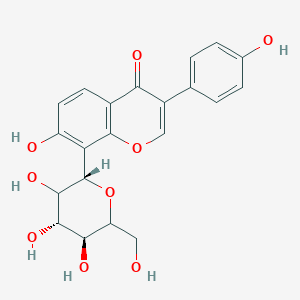| MeSH term | MeSH ID | Detail |
|---|---|---|
| Diabetes Mellitus, Type 2 | D003924 | 87 associated lipids |
| Diabetes Mellitus, Experimental | D003921 | 85 associated lipids |
| Alzheimer Disease | D000544 | 76 associated lipids |
| Coronary Disease | D003327 | 70 associated lipids |
| Liver Cirrhosis | D008103 | 67 associated lipids |
| Reperfusion Injury | D015427 | 65 associated lipids |
| Parkinson Disease | D010300 | 53 associated lipids |
| Fatty Liver | D005234 | 48 associated lipids |
| Ischemic Attack, Transient | D002546 | 42 associated lipids |
| Arthritis | D001168 | 41 associated lipids |
SCHEMBL105486
Kakonein is a lipid of Polyketides (PK) class. Kakonein is associated with abnormalities such as Fatty Liver, Chronic liver disease, Morphologically altered structure, Hypertensive disease and Cardiovascular Diseases. The involved functions are known as protein expression, Extravasation, Liver damage, mRNA Expression and cell activation. Kakonein often locates in Body tissue, Hepatic, Microvilli, Cytoplasm and Membrane. The associated genes with Kakonein are TJP1 gene, CD14 gene, iberiotoxin, AT-Rich Interactive Domain-Containing Protein 1A and NKS1 gene. The related lipids are dehydrosoyasaponin I and Steroids. The related experimental models are Knock-out.
Cross Reference
Introduction
To understand associated biological information of SCHEMBL105486, we collected biological information of abnormalities, associated pathways, cellular/molecular locations, biological functions, related genes/proteins, lipids and common seen animal/experimental models with organized paragraphs from literatures.
What diseases are associated with SCHEMBL105486?
SCHEMBL105486 is suspected in Chronic liver disease, Hypertensive disease, Cardiovascular Diseases, Myocardial Infarction, Cerebrovascular accident, Fatty Liver and other diseases in descending order of the highest number of associated sentences.
Related references are mostly published in these journals:
| Disease | Cross reference | Weighted score | Related literature |
|---|
Possible diseases from mapped MeSH terms on references
We collected disease MeSH terms mapped to the references associated with SCHEMBL105486
PubChem Associated disorders and diseases
What pathways are associated with SCHEMBL105486
There are no associated biomedical information in the current reference collection.
PubChem Biomolecular Interactions and Pathways
Link to PubChem Biomolecular Interactions and PathwaysWhat cellular locations are associated with SCHEMBL105486?
Visualization in cellular structure
Associated locations are in red color. Not associated locations are in black.
Related references are published most in these journals:
| Location | Cross reference | Weighted score | Related literatures |
|---|
What functions are associated with SCHEMBL105486?
Related references are published most in these journals:
| Function | Cross reference | Weighted score | Related literatures |
|---|
What lipids are associated with SCHEMBL105486?
Related references are published most in these journals:
| Lipid concept | Cross reference | Weighted score | Related literatures |
|---|
What genes are associated with SCHEMBL105486?
Related references are published most in these journals:
| Gene | Cross reference | Weighted score | Related literatures |
|---|
What common seen animal models are associated with SCHEMBL105486?
Knock-out
Knock-out are used in the study 'MATE2 mediates vacuolar sequestration of flavonoid glycosides and glycoside malonates in Medicago truncatula.' (Zhao J et al., 2011).
Related references are published most in these journals:
| Model | Cross reference | Weighted score | Related literatures |
|---|
NCBI Entrez Crosslinks
All references with SCHEMBL105486
Download all related citations| Authors | Title | Published | Journal | PubMed Link |
|---|---|---|---|---|
| Yamaki K et al. | Effects of naturally occurring isoflavones on prostaglandin E2 production. | 2002 | Planta Med. | pmid:11859455 |
| Lee JS et al. | The effect of Puerariae radix on lipoprotein metabolism in liver and intestinal cells. | 2002 | BMC Complement Altern Med | pmid:12485466 |
| Cervellati R et al. | Evaluation of antioxidant activity of some natural polyphenolic compounds using the Briggs-Rauscher reaction method. | 2002 | J. Agric. Food Chem. | pmid:12475261 |
| Xu XH and Zhao TQ | Effects of puerarin on D-galactose-induced memory deficits in mice. | 2002 | Acta Pharmacol. Sin. | pmid:12100749 |
| Benlhabib E et al. | Composition, red blood cell uptake, and serum protein binding of phytoestrogens extracted from commercial kudzu-root and soy preparations. | 2002 | J Med Food | pmid:12495583 |
| Lee DS et al. | Fecal metabolic activities of herbal components to bioactive compounds. | 2002 | Arch. Pharm. Res. | pmid:12009030 |
| Keyler DE et al. | Toxicity study of an antidipsotropic Chinese herbal mixture in rats: NPI-028. | 2002 | J Altern Complement Med | pmid:12006125 |
| Yu BS et al. | RP-HPLC determination of puerarin in Chinese traditional medicinal preparations containing pueraria. | 2002 | J Pharm Biomed Anal | pmid:12367710 |
| Hsieh MT et al. | Effects of puerarin on scopolamine-, mecamylamine-, p-chloroamphetamine- and dizocilpine-induced inhibitory avoidance performance impairment in rats. | 2002 | Planta Med. | pmid:12391553 |
| Choo MK et al. | Antithrombotic and antiallergic activities of daidzein, a metabolite of puerarin and daidzin produced by human intestinal microflora. | 2002 | Biol. Pharm. Bull. | pmid:12392089 |
